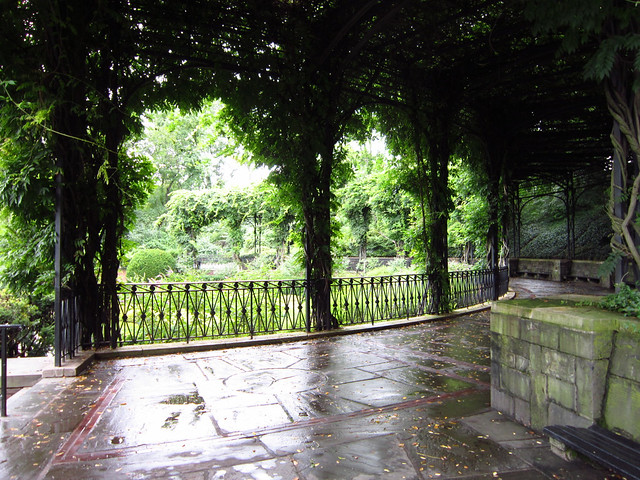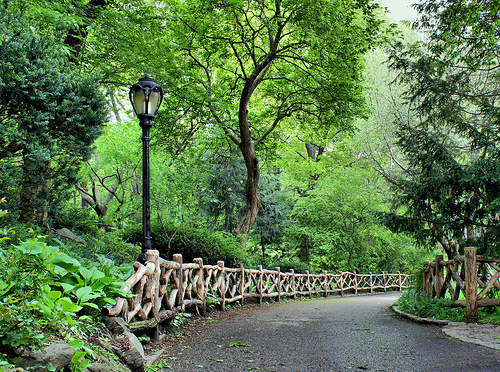

1. Conservatory Garden



The Conservatory Garden is Central Park’s six-acre formal garden. It is divided into three smaller gardens, each with a distinct style: Italian, French, and English. The Garden’s main entrance is through the Vanderbilt Gate, on Fifth Avenue between 104th and 105th Streets. This magnificent iron gate, made in Paris in 1894, originally stood before the Vanderbilt mansion at Fifth Avenue and 58th Street.

Vanderbilt Gate Entrance to the Conservatory Garden
The Italianate center garden is composed of a large lawn surrounded by yew hedges and is bordered by two exquisite allées of spring-blooming pink and white crabapple trees. A 12-foot high jet fountain plays on the western end of the lawn, backed by tiered hedges and stairs that lead up to a wisteria pergola. On the walkway under the pergola are medallions inscribed with the names of the original 13 states.
 Wisteria in the Italianate Garden
Wisteria in the Italianate Garden
The northern, French-style garden showcases parterres of germander and spectacular seasonal displays of spring tulips, and Korean chrysanthemums in autumn, all within an ellipse of Japanese holly. In the center is the charming Three Dancing Maidens fountain by German sculptor, Walter Schott.

To the south is the very intimate English-style garden. There are five mixed borders of trees, shrubs and perennial plants, and five seasonal beds featuring spring bulbs that are followed by annual flower displays. A slope of woodland plants lines the western edge of this garden. At the center is sculptor Bessie Potter Vonnoh’s lovely Frances Hodgeson Burnett Memorial Fountain, a tribute to the author of the children’s book, The Secret Garden. The children — a girl and a boy, said to depict Mary and Dickon, the main characters from the classic — stand at one end of a small water lily pool.

The Conservatory Garden is an officially designated Quiet Zone and offers a calm and colorful setting for a leisurely stroll, and intimate wedding, or an escape with a good book.
For many years the garden was tended by volunteers from the Garden Club of America and in 1983 it was restored by the Central Park Conservancy.
2. The North Woods


Perhaps the most secluded and peaceful area of Central Park, the North Woods (located at Central Park’s northwest corner) offers a taste of the Adirondack Mountains just a few subway stops away from Times Square.
The North Woods is one of the Park’s three woodlands (along with the Ramble and Hallett Nature Sanctuary), offering people and wildlife an oasis of nature in the middle of New York City. The heart of the North Woods is the Ravine. Fallen trees, or snags, are left where they land (unless hazardous or obscuring paths), providing nutrients to surrounding plants, homes to wildlife and a natural look to the landscape.
Once entering through the magnificent rustic Glen Span Arch at the eastern edge of the Pool (between 100th and 103rd Streets), Park visitors are treated to a view of the Loch, a stream rebuilt by the Conservancy in the 1990s. The North Woods is a favorite spot of birdwatchers and hikers. Free guided tours are available regularly. You can learn more about the North Woods, and the Park’s other woodlands (the Ramble and the Hallett Nature Sanctuary), through one of our Woodland Discovery Programs.
http://www.centralparknyc.org/things-to-see-and-do/attractions/north-woods.html
http://www.centralparknyc.org/things-to-see-and-do/discovery-programs.html?_ga=1.262214668.1291867245.1414013063

3. The Pool

 The Pool
The Pool
 Waterfall at Pool
Waterfall at Pool
With its grassy banks, weeping willows, and rushing waterfall, the Pool is one of the most idyllic spots in the Park. Central Park’s designers, Frederick Law Olmsted and Calvert Vaux, constructed the Pool by damming up a natural stream that was known as Montayne’s Rivulet. They sent the water along a northeastward course to form both the Loch and the Harlem Meer. Today, the water that gushes out of a grotto on the Pool’s southern shoreline is in actuality New York City drinking water that comes from a pipe hidden deep in the rocks. Many species of birds, fish, and amphibians can be seen at the Pool. In 2003, Central Park Conservancy completed a restoration of the Pool, protecting it as a healthy environment for wildlife and a picturesque landscape for Park visitors.

Glen Span Arch is in the North Woods

The Loch is in the North Woods
Winding through the Ravine, the Loch, Scottish for “lake,” is partially fed by a natural watercourse, known in the 17th and 18th centuries as Montayne’s Rivulet. It flows under Glen Span and Huddlestone arches before connecting to the Meer. The stream, designed by Frederick Law Olmsted and Calvert Vaux, is dammed in several places to create three magnificent cascades, some of the greatest features of engineering and art.


The Rustic Bridge is in the North Woods
The second of the Loch Cascades [Waterfalls is next to the Rustic Bridge

The Wildflower Meadow is north and west of the Rustic Bridge.
The Huddlestone Cascade is beneath the Wildlower Meadow; and the Huddlestone Arch is west of that.
 Huddlestone Arch
Huddlestone Arch
 Huddlestone Cascade
Huddlestone Cascade


Manhattan’s Adirondacks [Number 7 on the Above Map] is in the North Woods

Huddlestone Arch is in the North Woods

The Ramble is South of the North Woods

Tupelo Meadow is in the Ramble. During fall, a giant, 3-trunked Tupelo turns brilliantly red [Number 1 on the Ramble Map]

Bonfire Rock is near the Tupelo Meadow

The Head of the Gill [Stream] is in the Ramble [Number 2 on the Ramble Map].


“The Gill is the main stream that bisects theRamble from its source at 77th Street just east of Azalea Pond and travels down the rocky slope of the Gorge where it trickles beneath Gill Bridge 21 into the Lake.
Following the path of the Gill is the true adventure of the Central Park Ramble.
With its circuitous route over a rocky rustic terrain it unveils to the traveler a unique habitat embodying the romance of nature and the excitement of the City skyline, which is never far from view.
Yet here in the Ramble wandering along the edge of the Gill it is easy to forget that a city exists beyond its waters.
With the rushing sound of three cascades along the way from its source at a high grouping of bedrock mass to the Gorge where the stream drapes the edges of a steep rocky incline it is a magical path through a magical wilderness.”
 Gill Bridge 21
Gill Bridge 21
 Gill Bridge 21
Gill Bridge 21
 Azalea Pond Bridge
Azalea Pond Bridge
“Azalea Pond Bridge is a small rustic bridge beneath which waters from the Gill feed the habitat of Azalea Pond.“
 Azalea Pond
Azalea Pond
“Fed by the Gill, Azalea Pond in the Central Park Ramble is a small pond centerpiece of a well-preserved natural habitat frequented by bird watchers and nature lovers alike. Its blooming azaleas in the spring are a spectacle to view and the many species that frequent this area can always be found with enough perseverance.” This is on the northern part of The Ramble.

Bow Bridge
 The Gorge
The Gorge
“With its rocky incline and rushing cascade the Gorge provides the Gill’s final descent to the Lake. Aside from the opportunity for the best climb in Central Park the summit of the Gorge also provides an incredible view of all it oversees.
For many the Gorge all but defines the Ramble with its true wilderness atmosphere including a high Overpass and the cascading Gill which passes beneath it with a rush of sound that makes any visitor to the Park look down and around at the surrounding trees and hanging foliage in awe.

Belvedere Castle


Shakespeare Garden Bridge
The Shakespeare Garden is north of Belvedere Castle


The 20-acre Lake is the largest of Central Park’s naturalistic water bodies.

Bethesda Fountain

The massive, Bethesda Fountain is South of the Eastern side of the Lake

From this spot, you can see the Loeb Boathouse

The Bethesda Fountain [26 feet tall] is the tallest in New York City.


The Lake

Gapstow Bridge in Central Park
Curving gracefully over the neck of the Pond at 59th Street, Gapstow is one of the iconic bridges of Central Park. It is the second bridge in its place. The first, a much more elaborate wood and iron bridge, designed by Jacob Wrey Mould, deteriorated and was replaced in 1896.

 The Pond
The Pond

Entrance to the Central Park Zoo.
 Central Park Zoo is just beyond The Pond
Central Park Zoo is just beyond The Pond


 North Woods
North Woods
 Glen Span Arch
Glen Span Arch The Loch
The Loch
















































 Wisteria in the Italianate Garden
Wisteria in the Italianate Garden




 Waterfall at Pool
Waterfall at Pool







 Gill Bridge 21
Gill Bridge 21 Gill Bridge 21
Gill Bridge 21 Azalea Pond Bridge
Azalea Pond Bridge Azalea Pond
Azalea Pond
 The Gorge
The Gorge





















 Gill Bridge 22
Gill Bridge 22 Gill Rock
Gill Rock
 Rustic Shelter
Rustic Shelter Rustic Stone Arch
Rustic Stone Arch
 Bank Rock Bay
Bank Rock Bay

 Turtle Pond
Turtle Pond

